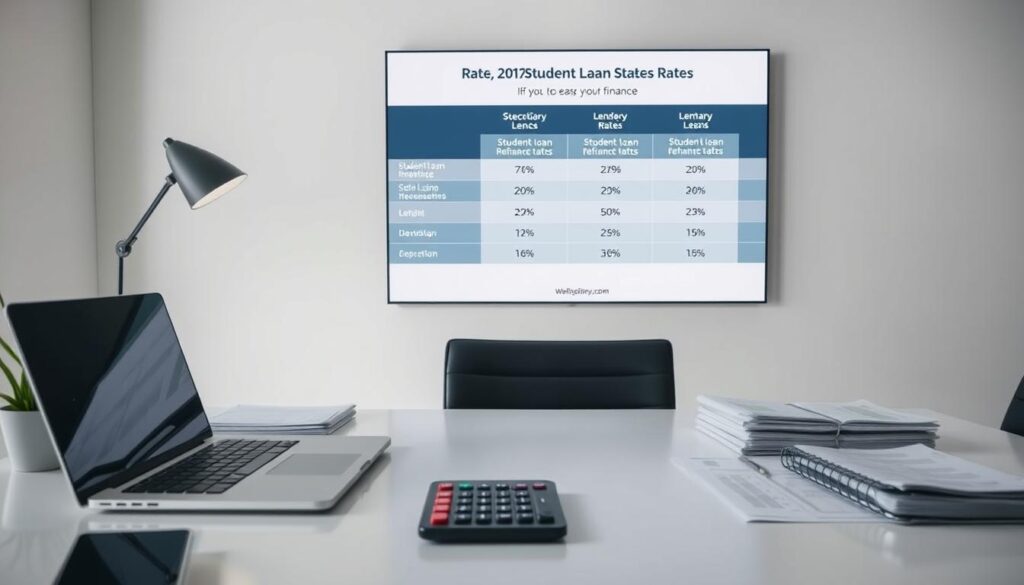Refinance Your Student Loans Today – Competitive Rates
Did you know over 44 million Americans owe more than $1.7 trillion in student loan debt? Refinancing your loans can help manage this debt. It could save you thousands of dollars in interest over time.
Dealing with loan refinancing can seem tough. But, with good rates and flexible terms, it’s a solid choice for many. By refinancing, you can turn multiple payments into one. Often, this payment is at a lower interest rate than before.
We’ll dive into the details of student loan refinance options. We’ll look at the benefits, who can apply, and how to refinance. This will help you make a smart choice for your financial future.
Key Takeaways
- Refinancing can significantly lower your monthly payments and total interest paid.
- Understanding your eligibility is crucial before applying.
- Choosing the right lender is key to a successful refinance.
- The refinancing process can be straightforward with the right guidance.
- It’s essential to weigh the potential risks and benefits.
Understanding Student Loan Refinancing
Student loan refinancing is a way to replace old loans with a new one at a lower interest rate. This can make your finances simpler and save you money on interest over time.
What is Student Loan Refinancing?
Refinancing student loans means getting a new loan from a private lender to pay off old loans. According to NerdWallet, it’s like swapping your old education debt for a new, cheaper loan. The new loan might have a different interest rate or repayment term than the old ones.
Key aspects of student loan refinancing include:
- Replacing multiple loans with a single loan
- Potentially lowering the interest rate
- Changing the repayment term
- Switching from a variable to a fixed interest rate or vice versa
How Does Refinancing Work?
To refinance, you apply for a new loan with a private lender. They check your credit, income, and other factors to decide the new loan’s terms. If you get approved, the new lender pays off your old loans, and you start repaying the new one.
Remember, refinancing federal loans with a private lender means losing federal benefits like income-driven repayment plans and Public Service Loan Forgiveness.
Benefits of Refinancing Student Loans
Refinancing can bring several benefits, including:
- Lower Interest Rates: Getting a lower interest rate can save you money over time.
- Simplified Loan Management: Combining multiple loans into one can make managing your finances easier.
- Improved Cash Flow: Lowering your monthly payments can help your cash flow.
Before refinancing, think about your financial situation, the new loan’s terms, and if the benefits are worth it.
Reasons to Refinance Your Student Loans
Refinancing your student loans can help you save money and improve your credit score. It makes managing your debt easier and more straightforward.
Lower Interest Rates
One big reason to refinance is to get lower interest rates. Companies like ELFI Program from SouthEast Bank and Navy Federal Credit Union offer great rates. These rates can cut down what you pay over time.
Simplifying Loan Management
Refinancing can make your finances simpler. It combines multiple loans into one, with just one payment each month. This simplifies managing your payments and due dates.
Improving Credit Scores
Refinancing and paying off your loans can boost your credit score. Showing you can manage your payments well improves your credit. This opens up more financial opportunities later on.
Before refinancing, check your current finances. Look at options from top lenders, like the best student loan refinance companies. This helps you find the best deal for you.
Eligibility Criteria for Refinancing
Refinancing your student loans has its own rules. To get the best deals, you need to meet certain requirements.
Minimum Credit Score Requirements
A high credit score is key for good refinancing terms. Most lenders want a score of 650 or more. But, having a score over 700 can really help you get better rates.
Credit Score Tiers:
- Excellent Credit: 750+ – Qualify for the best rates
- Good Credit: 700-749 – Competitive rates available
- Fair Credit: 650-699 – May qualify but at higher rates
- Poor Credit: Below 650 – May not qualify or face high rates
Income and Employment Stability
Lenders also look at your income and job stability. They want to make sure you can pay back the loan. Having a steady income and a low debt-to-income ratio is important. Navy Federal Credit Union says a ratio below 36% is best for refinancing.
Types of Loans Eligible for Refinancing
Not all student loans can be refinanced. Most lenders accept federal and private loans. But, always check with the lender about their specific rules. Knowing your current loan details is key when refinancing.
| Loan Type | Eligible for Refinancing |
|---|---|
| Federal Student Loans | Yes |
| Private Student Loans | Yes |
| Parent PLUS Loans | Varies by lender |
Understanding these criteria helps you prepare for refinancing. It can lead to better terms for your student loans.
Choosing the Right Lender for Refinancing
Choosing the right lender for refinancing student loans is key. It can greatly affect your financial future.
Factors to Consider When Selecting a Lender
When picking a lender, look at several important factors.
- Interest Rates: Compare rates to find the best deal.
- Repayment Terms: Think about repayment flexibility, like loan length and deferment options.
- Fees: Check for any extra fees, like origination or late payment fees.
Comparing Interest Rates and Terms
It’s crucial to compare rates and terms among lenders. This helps find the best refinance option for you.
| Lender | Interest Rate | Repayment Term |
|---|---|---|
| NerdWallet | 3.75% – 12.99% | 5 – 20 years |
| Navy Federal Credit Union | 3.75% – 11.25% | 5 – 15 years |
| ELFI Program | 2.88% – 8.05% | 5 – 15 years |
Importance of Customer Service
Good customer service is vital for a smooth refinancing experience.
Choose lenders with responsive customer support. They should offer help through phone, email, and online chat.

The Refinancing Process Explained
To refinance your student loans, you’ll go through a few steps. These include applying and getting approved. Knowing the process can help make it easier.
Steps to Start Your Application
The first step is to start your application. You need to:
- Look for lenders with good rates and terms for you.
- Get your financial documents ready, like proof of income.
- Check your credit score to see if you qualify.
By doing these things, you can make your application smooth.
Document Requirements
When you apply to refinance, you’ll need to provide some documents. These are usually:
- Identification, like a driver’s license or passport.
- Proof of income, such as pay stubs or tax returns.
- Details about your current student loans, including statements and balances.
Timeframe for Approval
The time it takes to get approved varies. It depends on the lender and your situation. Generally, you can expect:
- An initial review of your application in a few days.
- A final decision after they check your documents and credit history.
- Funds to pay off your loans once you’re approved.
Some lenders might be faster, so it’s good to compare.
Understanding the refinancing process helps you make smart choices. You might even save money on interest.
Potential Risks of Refinancing
Refinancing student loans can be smart, but it comes with risks. It can lower your interest rates and make managing loans easier. Yet, there are downsides to think about.
Loss of Federal Loan Benefits
One big risk is losing federal loan benefits. Refinancing with a private lender means giving up federal loan perks. These include income-driven plans and Public Service Loan Forgiveness (PSLF). Bankrate says it’s key to weigh these benefits before deciding.
For example, if you work in public service and qualify for PSLF, refinancing could mean missing out on loan forgiveness after 120 payments.
Impact on Your Credit Score
Refinancing can also affect your credit score. Applying for refinancing leads to a hard credit check, which can lower your score. Also, not paying on time or consolidating loans can harm your credit.
To lessen this risk, pay on time and check your credit often. Look for lenders with flexible terms and no penalties for early payments.
Variable Interest Rate Risks
Variable interest rates are another risk. Some lenders offer rates that can change, possibly raising your payments. While rates might start low, they can jump up, making budgeting tough.
To dodge this, choose a fixed rate or carefully check your loan’s terms. NerdWallet and Navy Federal Credit Union warn about variable rates. They stress the need to understand the terms before agreeing.
In summary, refinancing can simplify your finances and save money. But, it’s important to know the risks. By understanding these and taking steps to reduce them, you can make a choice that fits your financial needs.
Frequently Asked Questions About Refinancing
Thinking about refinancing your student loans? You might wonder about the process and its effects. Refinancing can help lower your interest rates, make payments easier, or reach other financial goals.
How Much Can I Save by Refinancing?
One big reason to refinance is to save on interest. NerdWallet says you could save thousands by getting a lower rate. Here’s a quick example:
| Loan Amount | Original Interest Rate | Refinanced Interest Rate | Potential Savings |
|---|---|---|---|
| $30,000 | 6.00% | 4.00% | $3,000 |
| $50,000 | 7.00% | 5.00% | $6,500 |
Use a student loan refinance calculator to see how much you could save with your loan details.
When is the Best Time to Refinance?
When to refinance depends on your credit score, income, and interest rates. Navy Federal Credit Union says good credit and stable income are key when rates are low. Keep an eye on the market and your finances to find the best time.
“Refinancing your student loans can be a smart financial move, but it’s crucial to consider your individual circumstances and the current market conditions.” –
Can I Refinance While in School?
Yes, you can refinance while in school, but there are rules. SoFi, for example, offers refinancing for students with a co-signer. Think carefully about the pros and cons before deciding.
Knowing these answers can help you decide if refinancing is right for you.
Tips for a Successful Refinancing Experience
Refinancing your student loans can be smooth with the right help. To do it well, you need to be ready and know what to expect. This includes understanding the steps to refinance your loans.
Preparing Your Financial Documents
Getting your financial documents ready is a key step. Lenders like Navy Federal Credit Union and ELFI Program from SouthEast Bank need detailed info. They want proof of income, employment, and your credit history.
Having accurate and current documents helps a lot. It makes the application process easier.
Key documents to prepare include:
- Pay stubs or proof of income
- Employment verification letter
- Credit reports
- Identification documents
Keeping Track of Loan Terms
It’s important to know and keep track of your loan terms after refinancing. This means understanding your interest rate, repayment period, and any fees. Regularly check your loan statements to stay on track with your payments.
Tips for managing your loan terms effectively:
- Set up automatic payments to avoid missing due dates
- Regularly review your loan statements for any discrepancies
- Consider setting up alerts for payment due dates
Being Aware of Hidden Fees
Knowing about hidden fees is key when refinancing your loans. Some lenders might charge origination fees, late fees, or other costs. It’s important to read your loan agreement carefully to know all the costs.

Being informed and prepared helps you refinance smoothly and avoid extra costs. Using a student loan refinance calculator can also help you see the savings and terms of your new loan.
Taking the Next Steps Toward Refinancing
We’ve looked into student loan refinancing. Now, it’s time to move forward. Refinancing can help lower your interest rates and make managing your loans easier.
Scheduling a Consultation with Lenders
Start by talking to lenders like NerdWallet’s top picks or Navy Federal Credit Union. They can explain your student loan refinance choices. This will help you understand the student loan refinance rates and terms.
Evaluating Your Current Financial Situation
Check your finances to see if refinancing is right for you. Look at your income, expenses, and credit score. This ensures you qualify for the best best student loan refinance companies.
Making an Informed Decision for Your Future
Think carefully about your options and talk to lenders. This way, you can make a smart choice for your financial future. Look around and compare lenders to find the right one for you. This will help you smoothly switch to a better loan repayment plan.









